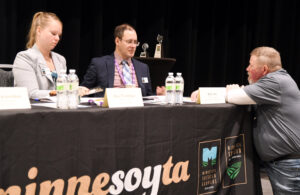Your neighbor might not be a farmer or even work in the agriculture industry. But agriculture’s impact reaches professions across myriad industries; we’re all links in a chain.
Over the past year, Minnesota Soybean Growers Association (MSGA) Secretary Kyle Jore participated in the Ag Leadership Network (ALN). The program’s mission set out to increase leadership and advocacy skills at the state and national level. For Jore, ALN did just that, and more.
“I learned more about the supply chain and how interconnected agriculture is in the region, how the whole of the economy hinges on it,” said Jore, who farms near Thief River Falls. “There are a lot of people that work in the space that don’t necessarily farm, and yet they are only a degree or two separated from the farm.”
The program, which focused on networking opportunities with influential agriculture figures in northwest Minnesota and the Red River Valley, began in September 2023 in conjunction with the Big Iron Farm Show in Fargo, N.D. For a few of the participants, Fargo was right in their backyard.
“It appealed to me because it looked like it was very much focused on northwestern Minnesota,” Jore said. “Obviously, I have an interest in that area because I’m from there and work there. I thought it would be a nice opportunity to get connected to more people in the region.”
Along with attending several agriculture conferences – including Prairie Grains Conference and LEAP Conference – ALN participants toured several factories and processing facilities throughout the region, such as the American Crystal Sugar factory in Moorhead, Agricultural Utilization Research Institute in Crookston and the North Dakota Mill and Simplot factory in Grand Forks.
“My favorite part definitely would have been the touring that we did of the different processing facilities in the region and learning more about what happens to the crops after they’re harvested,” Jore said. “Once they leave the field, they get marketed and processed which was really neat to see.”
Advocacy was another component of ALN. In March 2024, the group visited St. Paul to meet with legislators from their districts and have conversations about the impact of policy on rural Minnesota. For Jore, it was only his second time visiting the state Capitol since grade school.
The finale of the program was a visit to the nation’s capital, Washington, D.C., Jan. 14-16, mere days before President Donald Trump’s inauguration.

“It’s imperative that our state legislators (in D.C.) hear directly from the people that their policies affect,” said Brian Sorenson, executive director of the Minnesota Association of Wheat Growers, which co-sponsored ALN. “That’s why Hill visits are a critical component of the ALN program. We want the participants to gain firsthand experience meeting with legislators and having direct conversations with them, so they can be more prepared when they assume leadership roles in the future.”
‘Wealth of knowledge’
While in D.C., ALN visited the Canadian Embassy, meeting with Agriculture and Fisheries Counsellor Sonja Frohberg. With the U.S. exporting more to Canada than to China, Japan and the United Kingdom combined, every $1 billion in U.S. agriculture and agri-food exports means 8,000 American jobs and $1.3 billion in U.S. economic activity. Canada is also the fourth-largest purchaser of U.S. soymeal, a partnership that valued $614 million in 2023. A potential trade war may have been on the horizon while the group was visiting (at press time, the U.S. and Canada agreed to pause tit-for-tat tariffs), but the tone of conversation remained positive.
“When we left D.C., I gathered that everybody was expecting tariffs, that it was inevitable, but also hopeful that they weren’t going to be permanent,” said Jore, who lives about 70 miles from the Canadian border.
Jore isn’t a stranger to leadership roles thanks to his role on MSGA’s executive officer team, which he joined in 2024; yet he still found value in ALN.
“With MSGA, I have the privilege of representing farmers as we engage with policy makers and I think having a better grasp of the magnitude of the effects of policy on people that have jobs, that work in foods, is something that I wouldn’t have had quite to the extent without participating in the program,” said Jore, who joined MSGA’s board in 2022 and represents Pennington-Red Lake counties.
MSGA President Darin Johnson praised Jore’s intellect and resume, from his background as a professor to his grasp of crop insurance as head of crop insurance development at Watts and Associates. When MSGA’s secretary walks into a room, he just might be the smartest person in the space he occupies.
“Kyle brings a wealth of knowledge to MSGA,” Johnson said. “He’s well connected, especially with some of our lawmakers, and is so passionate about agriculture and farm policy.”
During MSGA’s March 2025 meeting in Washington, D.C., with Senate Ag Committee staffers, Johnson was stumped by a question about crop insurance.
“I wish Kyle was here to answer that,” Johnson said.
The staffers knew exactly to whom Johnson was referring.
“Oh, Kyle Jore?” Josh Tonsager, a senior Senate Ag Committee aide, said. “Yeah, we know Kyle.”
Unique experiences
Jore said he’s pursuing leadership opportunities for multiple reasons.
“We get siloed into our areas of expertise and our fields and we don’t necessarily get great opportunities to engage with other people or get in-depth looks into other parts of agriculture,” Jore said. “So having leadership opportunities like this program to engage with other people really broadens perspectives. It’s good because it helps us cross over our different areas of expertise.”
ALN’s comprehensive look at Minnesota agriculture made the experience invaluable to Jore.
“I have a fair amount of exposure to a lot of things, and yet, I learned a ton, and I met a lot of people, and went to a lot of places that were new to me,” Jore said. “We had a really great group of people that spread across all different aspects of the industry, and I think that was unique and special. There was someone there from ag communications, we had people from machinery and agronomy, we had farmers representing different commodities, we had bankers. Having that breadth of experience come together and get to know each other was awesome.”

